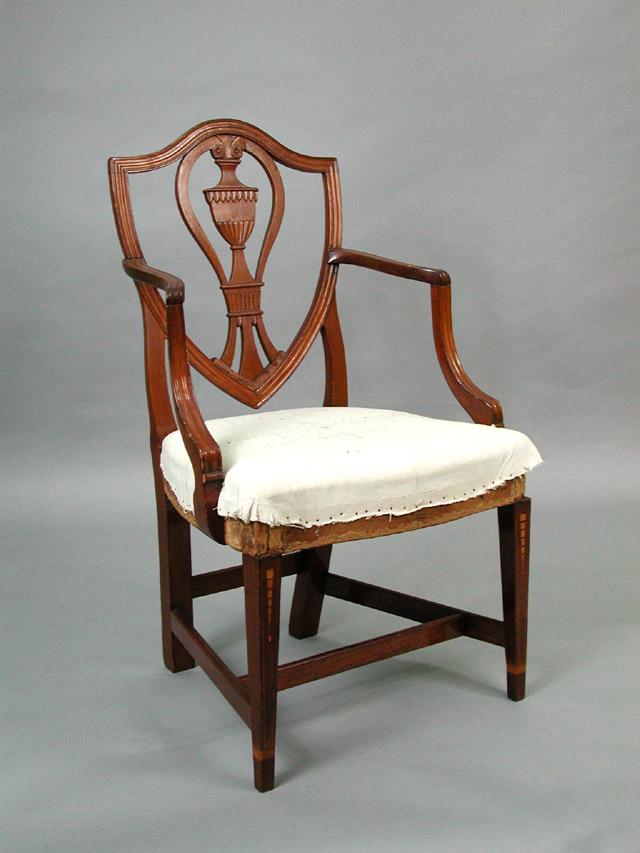Side Chair
Furniture MakerAttributed to the shop of
Aaron Chapin
(American, 1753 - 1838)
Original OwnerOriginally owned by
Reverend William Robinson
(American, 1754 - 1825)
Date1791-1800
MediumCherry, green velvet, brass nails
DimensionsPrimary Dimensions (overall height x width x depth): 37 7/16 x 21 7/8 x 20 5/16in. (95.1 x 55.6 x 51.6cm)
ClassificationsFurniture
Credit LineBequest of George Dudley Seymour
Object number1945.1.1159
DescriptionCherry side chair with an arched crest rail, pierced urn-back splat, tapered front legs, and over-the-rails upholstery in the Federal, or early neoclassical, style. The back of the chair is formed by an arched crest rail, with squared sides, atop two stiles. Centered below the arch of the crest rail is a pierced splat with an urn in the top center; the front of the urn is carved with a double layer of vertical flutes, with a recess in the center of each flute. The urn rests atop a curved ribbon of wood that crosses through the middle of the splat. The urn is surrounded by a pointed arch and by curved ribs. Each curved rib has a carved rosette on top and a raised bead along the outer edge; the ribs form the outside edges of the splat. The pointed arch and the curved ribs continue below the curved ribbon of wood to the bottom of the splat. The splat is joined at the bottom to a tapered splat shoe just above the back seat rail. The front of each stile, above the seat, and the front of the crest rail are molded with two wide recessed flutes. Above the seat, each stile curves slightly to conform to the shape of the upper splat, and is slanted back. Below the seat, each stile forms a back leg which is slanted back and also slanted toward the center back of the chair. The seat is trapezoidal with a serpentine front seat rail and straight side rails. It is upholstered with over-the-rails green and tan cut velvet (replaced) that is held in place with a swaged line of brass nails over a straight line of brass nails on the front and side seat rails. The front legs are tapered and extend from the height of the seat down to the foot; the front and outer side of each front leg is molded with two wide recessed flutes and a bead at each edge. Each side and back of the chair has a plain rectangular stretcher connecting the legs. A medial stretcher joins the two side stretchers.
Condition: The upholstery is stained and in poor condition; the cover is replaced with a cut green velvet that is now badly worn to reveal only the tan backing material below. The front edge of the upholstered seat is split, revealing the cotton stuffing below. The black material on the underside of the seat frame is torn. All the corner blocks are replaced. The feet are replaced.
Design and Construction Details: The crest rail is supported on a tenon at the top of each stile. Above the seat, the back of the stiles are rounded; the back of the crest rail is rounded as well. The splat is tenoned into the crest rail above and into the back seat rail below. The splat shoe is nailed down on top of the back seat rail, and has a cut-out at the back to accommodate the bottom of the splat. The back seat rail is tenoned and pinned into the stiles. Each side seat rail is tenoned through the stile in the back; two small wedges are inserted through the back of each tenon. The side and front seat rails are probably tenoned into the top of the front legs. The serpentine front seat rail is formed from a solid board. Each interior corner of the seat frame has a triangular corner block (all replaced) held in place with four screws. The interior corners of the front and back legs are canted. The back and side stretchers are tenoned into the lower legs. The medial stretcher dovetailed to the side stretchers.
Upholstery. The side chair is upholstered with over-the-rails cut green velvet (replaced, badly worn) that is held in place with a row of swaged brass nails over a row of straight brass nails along the front and side seat rails. Below the velvet is cotton stuffing (later addition), over a linen undercover (possibly original), stuffing, sackcloth, and webbing (probably original) that is tacked to the top of the seat rails. The bottom edges of the velvet are nailed to the underside of the seat rails. The remnants of a black linen are also nailed to the underside of the seat rails.
NotesHistorical Note: Urn-back Chairs. This chair is one of a group of chairs generally known as urn-back chairs because of the large urn shape in the pierced splat on the back of the chair. This form is most closely associated with the shop of Aaron Chapin and the shop of Samuel Kneeland and Lemuel Adams. The Aaron Chapin shop made a set of nine urn-back chairs for Oliver and Abigail Ellsworth, now owned by the Oliver Ellsworth Homestead in Windsor, Connecticut. These chairs are documented in a 1791 bill to Ellsworth from Aaron Chapin, in the Oliver Ellsworth Papers, container 1, Library of Congress. Two of the chairs are depicted in a 1792 portrait of the Ellsworths by Ralph Earl now owned by the Wadsworth Atheneum, Hartford, Connecticut. The Ellsworth chairs have crisply carved urns and rosettes and construction practices the same as those used in the shop of Eliphalet Chapin, including through tenons with small wedges visible at the back of the stiles. Samuel Kneeland and Lemuel Adams made a set of six urn-back chairs that survive with a receipt dated 13 December 1793. These are now at the Winterthur Museum (accession number 1967.151.1). These have carved volutes and the side seat rails are not tenoned through the stiles. The urn-back chair gained widespread popularity throughout southern New England, including Massachusetts and Rhode Island. (Hunt 4/12/2006)Condition: The upholstery is stained and in poor condition; the cover is replaced with a cut green velvet that is now badly worn to reveal only the tan backing material below. The front edge of the upholstered seat is split, revealing the cotton stuffing below. The black material on the underside of the seat frame is torn. All the corner blocks are replaced. The feet are replaced.
Design and Construction Details: The crest rail is supported on a tenon at the top of each stile. Above the seat, the back of the stiles are rounded; the back of the crest rail is rounded as well. The splat is tenoned into the crest rail above and into the back seat rail below. The splat shoe is nailed down on top of the back seat rail, and has a cut-out at the back to accommodate the bottom of the splat. The back seat rail is tenoned and pinned into the stiles. Each side seat rail is tenoned through the stile in the back; two small wedges are inserted through the back of each tenon. The side and front seat rails are probably tenoned into the top of the front legs. The serpentine front seat rail is formed from a solid board. Each interior corner of the seat frame has a triangular corner block (all replaced) held in place with four screws. The interior corners of the front and back legs are canted. The back and side stretchers are tenoned into the lower legs. The medial stretcher dovetailed to the side stretchers.
Upholstery. The side chair is upholstered with over-the-rails cut green velvet (replaced, badly worn) that is held in place with a row of swaged brass nails over a row of straight brass nails along the front and side seat rails. Below the velvet is cotton stuffing (later addition), over a linen undercover (possibly original), stuffing, sackcloth, and webbing (probably original) that is tacked to the top of the seat rails. The bottom edges of the velvet are nailed to the underside of the seat rails. The remnants of a black linen are also nailed to the underside of the seat rails.
Status
Not on view












